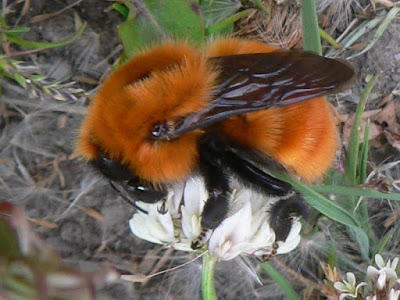Back from another wonderful trip to South America - you'll be seeing more on that very soon - so this offering is 'live' again. Last time, in looking at some orange reptiles and frogs, I mentioned the class of chemicals known as pterins, which were first discovered as pigments in the wings of Pierid butterflies; the best-known of these are the ubiquitious Cabbage Whites, but there are many yellow, and of course orange ones too. Since then pterins have been found in the wings of many other butterflies, as well as wasps and crustaceans, but it is highly likely that they are the basis of other orange invertebrates too. But we might as well start with some orange butterflies from various places, including right here in Canberra.
 |
| Australian Painted Lady (though this one is a male Lady!) Vanessa kershawi, on Isotoma sp., Australian National Botanic Gardens, Canberra. |
And I can't really omit a butterfly with Orange in its name, though I reckon it's stretching the definition a tad - not for the first time, as observed in my previous Orange postings.
I can offer orange butterflies from Africa and South America too, both of which (if my identification is correct, by no means something to be assumed) are also Nymphalids.
 |
| Cymothoe sp., Bwindi Impenetrable National Park, Uganda. This is a genus of some 70 species restricted to the great forests of West and Central Africa. |
 |
| Two Red Flashers Panacea prola, (with a blue friend, hitherto unidentified by me), Manu National Park. Despite the common name, these look pretty orange to me! |
Orange wasps, you may recall, have also been identified as deriving their colour from pterins. Here are a couple of examples.
 |
| Spider Wasp, Family Pompilidae, Machu Picchu, Peru. Like the butterflies, the wings are the orange aspect here; this is not always the case however. |
I assume, but do not know, that the orange legs and bodies of many other wasps are also down to pterins.
 |
| 'Fire Wasp' (local name, for its ferocious sting) Urabamba, Peruvian Andes. |
 |
| Potter Wasp, Family Vespidae, Kata Tjuta NP, central Australia. She needs a lot of water to construct the characteristic mud nests. |
 |
| Another spider-hunter, this time near Winton, western Queensland. |
As for other orange insects, I'm not aware of work that has been done to identify the relevant pigments, but it seems likely that pterins are also involved.
 |
| Chrysomelid beetle munching its way through an acacia phyllode, Whyalla Conservation Park, South Australia. |
 |
| Ladybird Coccinella transversalis, Namadgi NP near Canberra. |
 |
| Harlequin Bug, Family Scutelleridae, Undara National Park, Queensland. |
And lastly, moving away from the bush to the sea, pterins have been identified in orange crustaceans, presumably including this lovely crab.
So, that will about do us for our excursion into the orange world. Except that I should come back one day to celebrate some orange flowers - but perhaps not just yet.
BACK ON WEDNESDAY




4 comments:
Hello I am curious to know if the Patagonian humble bee can be found in Southern Italy? I live in Puglia the heel of Italy and yesterday I saw what looked like a Patagonian bumble bee on our lavender. Completely orange with black head and legs and wings. Beautiful bee and so vibrant. I haven't seen one here before. Thanks Sarah
Hello Sarah. I think it's most unlikely that the Patagonian bee is in Europe, but there are closely related European species. I'm not very good on Europe though, sorry. It might be worth looking here https://en.wikipedia.org/wiki/Bumblebee and at the list under Taxonomy. Otherwise a general search should throw something up, especially if you can get a photo. And if you can do that I could put you on to someone who would know. Good luck!
I am in Manitoba Canada, & have been seeing alot of orange bumble bee's this year. This is the first info I have seen on them
Hello Martha, and nice to hear from you. Ironic that you should have to come to an Australian site for information on your own bees! Unfortunately I know nothing of North American bees, but maybe you could look up that genus name in a Canadian site, and see what comes up.
Post a Comment